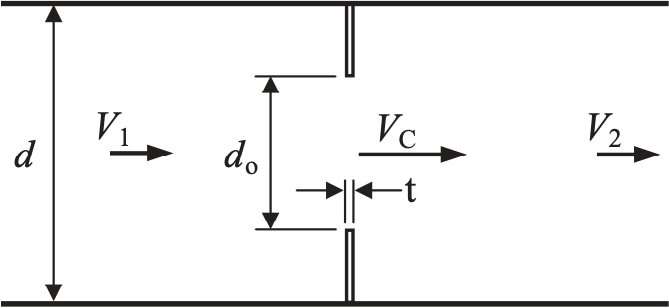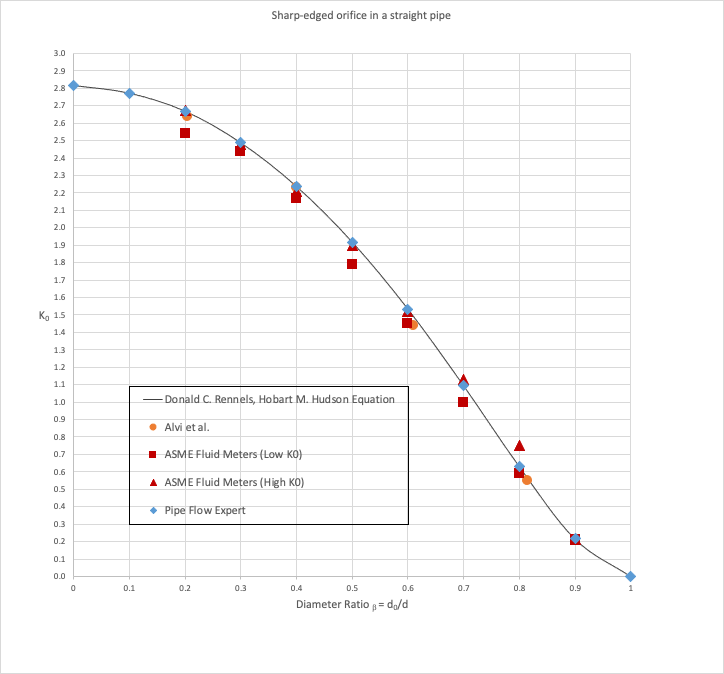Case 51: Water - Sharp-edged Orifice Loss Coefficient in a Straight Pipe
Reference: Pipe Flow – A Practical and Comprehensive Guide, 2012, Publisher Wiley, Donald C. Rennels, Hobart M. Hudson, Chapter 13, Page 140
Pipe Flow Expert File: Case_51_Water_Sharp_Edged_Orifice_Straight_Pipe.pfe
Problem Description:
A straight pipe contains a sharp-edged single-hole orifice.

Use different diameter ratios ( = d0/d) to calculate the loss coefficient (k0) of the orifice, where d0 is orifice diameter and d is the pipe diameter.
The published data uses different calculation methods:
Rennels / Hudson, Equation 13.3, ASME Fluid Meters, and Alvi et al.

Pipe Flow Expert Parameters:
Fluid Data: Water at, 68 °F
Pipe Data: Internal diameter 4 inches, wall thickness 0.237 inches, roughness 1881 micro-inches
Nine systems, each with an inflow demand of 0.4 ft3/sec, were used to model orifice diameter to pipe diameter ratios ( = d0/d) from 0.1 through to 0.9.
Result Comparison:
Pipe Flow Expert Calculated Results and Published Graph Readings of Orifice Loss Coefficient (k0):
|
Orifice Diameter / Pipe Diameter (d0/d) |
ASME Fluid Meters (High k0) |
ASME Fluid Meters (Low k0) |
Alvi et al. (k0) |
Donald C. Rennels, Hobart M. Hudson (k0) |
Pipe Flow Expert (k0) |
|
0.1 |
- |
- |
- |
2.77 |
2.77 |
|
0.2 |
2.67 |
2.54 |
- |
2.67 |
2.67 |
|
0.205 |
- |
- |
2.64 |
- |
|
|
0.3 |
2.48 |
2.44 |
- |
2.49 |
2.49 |
|
0.4 |
2.21 |
2.17 |
2.23 |
2.24 |
2.24 |
|
0.5 |
1.9 |
1.79 |
- |
1.92 |
1.92 |
|
0.6 |
1.52 |
1.45 |
- |
1.53 |
1.53 |
|
0.61 |
- |
- |
1.44 |
|
|
|
0.7 |
1.13 |
1 |
- |
1.09 |
1.09 |
|
0.8 |
0.749 |
0.59 |
- |
0.63 |
0.63 |
|
0.815 |
- |
- |
0.55 |
|
|
|
0.9 |
0.21 |
0.21 |
- |
0.22 |
0.22 |
Graphical Comparison of Results:

Commentary:
The published k0 loss coefficients compare well with the calculated results.
Note: Head Loss in m fluid = (k0 * v2) / 2g
- where v = fluid velocity in m/s at the entrance to the orifice, g = acceleration due to gravity in m/s2
- k0 is not the same as a standard k value (which is used in formulas where v = velocity in the pipe)

